Difference between revisions of "Rolleiflex SL35M"
Rebollo fr (talk | contribs) |
Ivanbranco (talk | contribs) |
||
| (42 intermediate revisions by 9 users not shown) | |||
| Line 1: | Line 1: | ||
| − | The | + | == The SL35M == |
| − | The | + | The '''Rolleiflex SL35M''' is a 35mm [[SLR]] camera launched by [[Rollei]] in 1976. |
| − | Rollei | + | The history of this camera is quite tormented. In the early 1970s, the German camera industry was facing severe difficulties. Despite this, Rollei tried to maintain their diversified product range, from the simple viewfinder cameras for the 110, the 126, and the 135 formats, to the more sophisticated [[Rollei 35]] compact, the traditional [[TLR]] medium-format [[Rolleiflex]], and even the prestigious medium-format SLR, the Rolleiflex SL66. The range also included a late-comer to the 35mm SLR family, developed in-house, the match-needle stop-down metered [[Rolleiflex SL35|Rolleiflex SL35]] and later the [[Rolleiflex SL35|Rolleiflex SL350]]. |
| − | + | The troubles in the camera business affected [[Zeiss Ikon]] critically, and in 1972 it was decided to end the camera production. Like Rollei, they had diversified their product range, trying to cover all the segments of the market, from simple amateur cameras to professional photographic systems. Zeiss Ikon was liquidated, and the factories, the brand names, the research results and the camera designs were all transferred to other hands. | |
| − | + | The [[Voigtländer]] name, formerly owned by Zeiss Ikon, was acquired by Rollei, together with the latest Zeiss Ikon 35mm SLR, the [[Zeiss Ikon SL706|SL706]], a further development of the [[Icarex]]. Rollei wanted to introduce this as a new model, the [[Voigtländer VSL|Voigtländer VSL 1 (TM)]] with only minor modifications, using the Voigtländer brand name. Both the SL706 and the VSL 1 (TM) were designed to accept the 42mm screw mount lenses. At the same time, Rollei intended to continue both the SL35 and the SL350, with the Rollei bayonet mount, requiring Rollei to supply their lenses in a multitude of lens mounts, which was less than rational for a range of cameras having a marginal market share. | |
| − | The | + | So, realizing this, Rollei decided in 1976 to end the production of the SL35 and SL350, and focus on the VSL 1. But quite unexpectedly they modified it to take the [[Rolleiflex SL35 lenses]], thus rationalizing the lens range in favour of the bayonet mount. Dropping their own product in favour of a newly aquired design was a drastic decision, but they released the new model as both the [[Voigtländer VSL|Voigtländer VSL 1 (BM)]] and the Rolleiflex SL35M, having the same body with just cosmetic changes. Despite these cameras complicated history, they were straightforward SLRs of the 70s with hot shoes and open aperture [[TTL]] match-needle meters. They had a decent design, with good ergonomic handling. |
| + | |||
| + | The camera finish was excellent, but not always up to the standards one would expect from a firm of Rollei's repute. The two new models were manufactured in Rollei's plant in Singapore, one of the first plants to be relocated to the far east. Unfortunately the production there was troubled with poor quality control, a situation that only improved slowly over the following years. The VSL 1 had chrome finish, while the SL35M came in black finish only, the top and baseplates being made of thin flimsy plastic. | ||
| + | |||
| + | The many changes inflicted on this range of SLRs did not help establish the buyers' confidence, and they never became a big success for Rollei. | ||
| + | |||
| + | {|class=plainlinks | ||
| + | ||[http://www.flickr.com/photos/heritagefutures/4716294353/in/pool-camerawiki/ http://farm5.static.flickr.com/4060/4716294353_1aaa8fa88c_m.jpg] | ||
| + | ||[http://www.flickr.com/photos/heritagefutures/4716943298/in/pool-camerawiki/ http://farm5.static.flickr.com/4065/4716943298_e8baab6b6d_m.jpg] | ||
| + | ||[http://www.flickr.com/photos/heritagefutures/4716940350/in/pool-camerawiki/ http://farm5.static.flickr.com/4067/4716940350_3533956828_m.jpg] | ||
| + | ||[http://www.flickr.com/photos/heritagefutures/4716944294/in/pool-camerawiki/ http://farm5.static.flickr.com/4058/4716944294_5dc3f0dc0e_m.jpg] | ||
| + | |} | ||
| + | {|class=plainlinks | ||
| + | ||[http://www.flickr.com/photos/heritagefutures/4716295733/in/pool-camerawiki/ http://farm5.static.flickr.com/4020/4716295733_cf9cde6005_m.jpg] | ||
| + | ||[http://www.flickr.com/photos/heritagefutures/4716938584/in/pool-camerawiki/ http://farm5.static.flickr.com/4018/4716938584_b319c43d3d_m.jpg] | ||
| + | ||[http://www.flickr.com/photos/heritagefutures/4716299127/in/pool-camerawiki/ http://farm5.static.flickr.com/4063/4716299127_8156c427dd_m.jpg] | ||
| + | |- | ||
| + | |colspan=4 align=center| Rolleiflex SL35M (images courtesy Dirk HR Spennemann) {{with permission}} | ||
| + | |} | ||
| + | |||
| + | == The SL35ME == | ||
| + | {{Flickr_image | ||
| + | |image_source= https://www.flickr.com/photos/draculro/29070990610/in/pool-camerawiki/ | ||
| + | |image= https://live.staticflickr.com/8080/29070990610_2881b4ac1b_n.jpg | ||
| + | |image_align= right | ||
| + | |image_text= Rolleiflex SL35ME | ||
| + | |image_by= Nicodemus Roger | ||
| + | |image_rights= with permission | ||
| + | }} | ||
| + | Rollei also decided to realize the Zeiss Ikon plans for a fully automatic aperture-priority SLR, called the '''Rolleiflex SL35ME''' or [[Voigtländer VSL|VSL 2 automatic]]. A meter needle visible in the finder indicates the automatically selected shutter speed. They were sold in black only, and are not renowned for their reliability. | ||
| + | |||
| + | The Rolleiflex SL35M and SL35ME were to be replaced by the [[Rolleiflex SL35E]] model within two years, in 1978. | ||
| + | |||
| + | Note: (TM) indicates "thread mount" and (BM) "bayonet mount", indicating the respective camera lens-mount. | ||
| + | |||
| + | == Bibliography == | ||
| + | * {{Matanle SLR}} Pp.107–9. | ||
| + | |||
| + | == Links == | ||
| + | In English: | ||
| + | * [https://web.archive.org/web/20170703124131/http://captjack.exaktaphile.com/rollei/dugrew.html Captain Jack's Rollei SL35 and Voigtländer VSL website] (archived), including: | ||
| + | ** [https://web.archive.org/web/20170428025822/http://captjack.exaktaphile.com/rollei/Rollei%20Cameras.htm SL35 and VSL bodies] | ||
| + | ** [https://web.archive.org/web/20170703102027/http://captjack.exaktaphile.com/rollei/Rolleilenses.htm SL35 and VSL lenses] | ||
| + | ** [https://web.archive.org/web/20170705083509/http://captjack.exaktaphile.com/rollei/Rolleilaccys.htm SL35 and VSL accessories] | ||
| + | * [http://web.archive.org/web/20050307002949/http://www.rolleiclub.com/rollei/sl35/models.htm Rollei 35mm SLRs] at the [http://web.archive.org/web/20050216043040/www.rolleiclub.com/rollei/index.htm Rollei Club] (the site is dead and the links point to the web archive version dated March 7, 2005) | ||
| + | * [http://www.butkus.org/chinon/rollei/rollei_sl_35_me/rollei_sl_35_me.htm Rolleiflex SL35ME manual] (.pdf format) at [http://www.butkus.org/chinon/ butkus.org's Orphan Cameras] | ||
| + | * [http://www.butkus.org/chinon/rolleiflex.htm For other versions of the SL35 cameras (SL35, SL35M, SL35 E, Rollie 35mm close up, SL26)] at OrphanCameras.com | ||
| + | In German: | ||
| + | * [http://www.klassik-cameras.de/WestdeutscheSLR.html The last West German 35mm cameras] in [http://www.klassik-cameras.de/index.html Frank Mechelhoff's camera site] | ||
| + | In Italian: | ||
| + | * [http://www.nadir.it/ob-fot/ROLLEI_SL35/articolo.htm Rolleiflex SL35 family] by Luca Vascon in [http://www.nadir.it/index.htm Nadir Magazine] | ||
| + | In French : | ||
| + | * [http://www.collection-appareils.fr/x/html/page_standard.php?id_appareil=1416 Rolleiflex SL 35M] on [http://www.collection-appareils.fr/general/html/francais.php www.collection-appareils.fr] by Sylvain Halgand | ||
| + | |||
| + | [[Category: German 35mm SLR]] | ||
| + | [[Category: Rollei]] | ||
| + | [[Category: R]] | ||
| + | [[Category: S|Sl35m]] | ||
| + | [[Category: 1976]] | ||
Latest revision as of 23:29, 14 January 2023
Contents
The SL35M
The Rolleiflex SL35M is a 35mm SLR camera launched by Rollei in 1976.
The history of this camera is quite tormented. In the early 1970s, the German camera industry was facing severe difficulties. Despite this, Rollei tried to maintain their diversified product range, from the simple viewfinder cameras for the 110, the 126, and the 135 formats, to the more sophisticated Rollei 35 compact, the traditional TLR medium-format Rolleiflex, and even the prestigious medium-format SLR, the Rolleiflex SL66. The range also included a late-comer to the 35mm SLR family, developed in-house, the match-needle stop-down metered Rolleiflex SL35 and later the Rolleiflex SL350.
The troubles in the camera business affected Zeiss Ikon critically, and in 1972 it was decided to end the camera production. Like Rollei, they had diversified their product range, trying to cover all the segments of the market, from simple amateur cameras to professional photographic systems. Zeiss Ikon was liquidated, and the factories, the brand names, the research results and the camera designs were all transferred to other hands.
The Voigtländer name, formerly owned by Zeiss Ikon, was acquired by Rollei, together with the latest Zeiss Ikon 35mm SLR, the SL706, a further development of the Icarex. Rollei wanted to introduce this as a new model, the Voigtländer VSL 1 (TM) with only minor modifications, using the Voigtländer brand name. Both the SL706 and the VSL 1 (TM) were designed to accept the 42mm screw mount lenses. At the same time, Rollei intended to continue both the SL35 and the SL350, with the Rollei bayonet mount, requiring Rollei to supply their lenses in a multitude of lens mounts, which was less than rational for a range of cameras having a marginal market share.
So, realizing this, Rollei decided in 1976 to end the production of the SL35 and SL350, and focus on the VSL 1. But quite unexpectedly they modified it to take the Rolleiflex SL35 lenses, thus rationalizing the lens range in favour of the bayonet mount. Dropping their own product in favour of a newly aquired design was a drastic decision, but they released the new model as both the Voigtländer VSL 1 (BM) and the Rolleiflex SL35M, having the same body with just cosmetic changes. Despite these cameras complicated history, they were straightforward SLRs of the 70s with hot shoes and open aperture TTL match-needle meters. They had a decent design, with good ergonomic handling.
The camera finish was excellent, but not always up to the standards one would expect from a firm of Rollei's repute. The two new models were manufactured in Rollei's plant in Singapore, one of the first plants to be relocated to the far east. Unfortunately the production there was troubled with poor quality control, a situation that only improved slowly over the following years. The VSL 1 had chrome finish, while the SL35M came in black finish only, the top and baseplates being made of thin flimsy plastic.
The many changes inflicted on this range of SLRs did not help establish the buyers' confidence, and they never became a big success for Rollei.
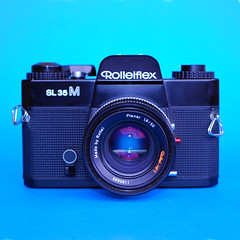
|
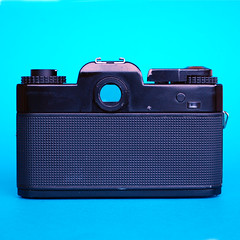
|

|

|
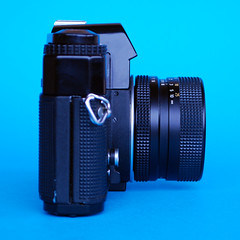
|
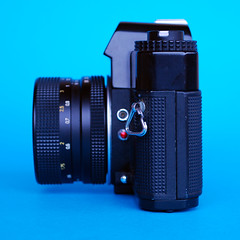
|
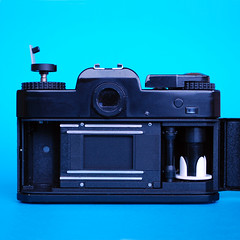
| |
| Rolleiflex SL35M (images courtesy Dirk HR Spennemann) (Image rights) | |||
The SL35ME

|
| Rolleiflex SL35ME image by Nicodemus Roger (Image rights) |
Rollei also decided to realize the Zeiss Ikon plans for a fully automatic aperture-priority SLR, called the Rolleiflex SL35ME or VSL 2 automatic. A meter needle visible in the finder indicates the automatically selected shutter speed. They were sold in black only, and are not renowned for their reliability.
The Rolleiflex SL35M and SL35ME were to be replaced by the Rolleiflex SL35E model within two years, in 1978.
Note: (TM) indicates "thread mount" and (BM) "bayonet mount", indicating the respective camera lens-mount.
Bibliography
- Matanle, Ivor. Collecting and Using Classic SLRs. London: Thames & Hudson, 1996. ISBN 0-500-01726-3. Pp.107–9.
Links
In English:
- Captain Jack's Rollei SL35 and Voigtländer VSL website (archived), including:
- Rollei 35mm SLRs at the Rollei Club (the site is dead and the links point to the web archive version dated March 7, 2005)
- Rolleiflex SL35ME manual (.pdf format) at butkus.org's Orphan Cameras
- For other versions of the SL35 cameras (SL35, SL35M, SL35 E, Rollie 35mm close up, SL26) at OrphanCameras.com
In German:
In Italian:
- Rolleiflex SL35 family by Luca Vascon in Nadir Magazine
In French :
- Rolleiflex SL 35M on www.collection-appareils.fr by Sylvain Halgand